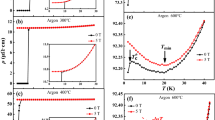Abstract
To investigate the mechanism for the development of large anisotropic resistive critical fields in deformed niobium, the dependence of the parallel critical fieldH ∥ on stress σ was measured in both compression and tension, for severely deformed niobium composites. the magnitude of ∂H ∥/∂ σ increased with strain up to a value of 27 times that of annealed niobium. Also, both tension and compression increasedH ∥. Both of these discrepancies from the thermodynamic predictions can be ascribed to the presence of double-ended dislocation pileups in the cell walls.
Similar content being viewed by others
References
J. R. Pearson and R. M. Rose:Met. Trans., 1970, vol. 1, p. 377.
D. C. Hill and R. M. Rose:Appl. Phys. Letters, 1970, vol. 17, p. 66.
D. C. Hill and R. M. Rose:Met. Trans., 1971, vol. 2, pp. 585–89.
K. M. Ralls:Phys. Letters, 1966, vol. 23, p. 29.
C. R. Hu and V. Korenman:Phys. Rev., 1969, vol. 178, p. 684.
D. R. Tilley:J. Phys. C, 1968, vol. 1, p. 243.
E. A. Lynton:Superconductivity, 2nd ed., p. 16, Methuen Monograph, London, 1964.
J. L. Olsen, K. Andres, H. Meier and H. de Salaberry:Z. Naturf. Sch., 1963, vol. 18A, p. 125.
B. Hillenbrand:Z. Angew. Phys., 1969, vol. 27, p. 12.
K. Luders:Z. Phys., 1966, vol. 193, p. 65.
G. A. Alers and D. L. Waldorf:Phys. Rev. Letters, 1961, vol. 6, p. 677.
J. P. Hirth and J. Lothe:Theory of Dislocations, chap. 12, McGraw-Hill, New York, 1968.
R. L. Fleischer:Phys. Letters, 1962, vol. 3, p. 111.
H. Mughrabi:Phil. Mag., 1968, vol. 18, p. 1211.
J. D. Livingston and H. W. Schadler:Prog. Mater. Sci., 1964, vol. 12, p. 185.
M. McKeehan and B. E. Warren:J. Appl. Phys., 1953, vol. 24, p. 52.
D. C. Hill: Ph. D. Thesis, Department of Metallurgy, M.I.T., Cambridge, Mass., 1970.
W. De Sorbo:Phys. Rev., 1963, vol. 132, p. 107.
Author information
Authors and Affiliations
Additional information
D. C. HILL, formerly National Science Foundation Trainee, Department of Metallurgy and Materials Science Massachusetts Institute of Technology, Cambridge, Mass.
M.I.T.
Rights and permissions
About this article
Cite this article
Hill, D.C., Rose, R.M. Superconductivity and dislocation cell structure in niobium: Stress effects. Metall Trans 2, 1433–1437 (1971). https://doi.org/10.1007/BF02913372
Received:
Issue Date:
DOI: https://doi.org/10.1007/BF02913372




